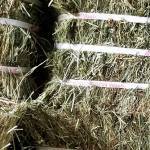Benefits of High-Temperature Steaming of Horse Hay

Wetting hay reduces allergens that contribute to asthma and decreases nonstructural carbohydrate content. Despite its benefits, soaking for even short periods of time can result in substantial loss of nutrients.
“When horse owners decide to soak hay, they should do so with the knowledge that important nutrients will be leached from the forage, including phosphorus, potassium, magnesium, sodium, and copper,” explained Kathleen Crandell, Ph.D., a nutritionist with Kentucky Equine Research. “To replace the nutrients lost from the water bath, nutritionists recommend that a high-quality vitamin and mineral supplement be fed with soaked hay.”
Further, soaking results in the production of significant wastewater. “High-temperature steaming, on the other hand, produces little wastewater, fails to leach nutrients, lowers nonstructural carbohydrates by as much as half, and decreases aeroallergens known to cause asthma,” Crandell informed.
Scientists at the Royal Agricultural University in the United Kingdom set out to characterize the bacterial profile of different hays subjected to soaking and high-temperature steaming.*
They sourced four different hays—two meadow hays and two Italian ryegrass hays—from a commercial grower and then exposed them to the following treatments: (1) soaked in 12 gallons (45 liters) of tap water at 61° F (16° C) for 12 hours; (2) placed in a commercial hay steamer for 60 minutes using 2 gallons (7 liters) of tap water in the boiler; and (3) left in a natural dry state. Samples were taken from all hays after treatment. Bacterial DNA was extracted and sequenced from all samples.
The researchers reported that, as expected, both soaking and high-temperature steaming reduced the number of viable bacteria known to contribute to respiratory disease. They also found that high-temperature steaming resulted in an increased number of beneficial bacteria associated with carbohydrate metabolism. In contrast, the abundance of gram-negative bacteria, which may have negative effects on health, increased when hay was soaked.
“In sum, these results support high-temperature steaming rather than soaking in many ways. If you have a horse that requires wet hay due to respiratory health problems or other issues and the only available alternative to feeding dry hay is soaking, then that method will suffice,” advised Crandell. ”Just remember to balance out the nutrients that may be lost with a balancer pellet or vitamin and mineral supplement.”
*Daniels, S., J. Hepworth, and M. Moore-Colyer. 2020. The haybiome: Characterising the viable bacterial community profile of four different hays for horses following different pre-feeding regimens. PLoS One 15(11):e0242373.








